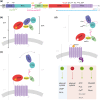The adhesion GPCR Adgrg6 (Gpr126): Insights from the zebrafish model
- PMID: 33735533
- PMCID: PMC11475505
- DOI: 10.1002/dvg.23417
The adhesion GPCR Adgrg6 (Gpr126): Insights from the zebrafish model
Abstract
Adhesion GPCRs are important regulators of conserved developmental processes and represent an untapped pool of potential targets for drug discovery. The adhesion GPCR Adgrg6 (Gpr126) has critical developmental roles in Schwann cell maturation and inner ear morphogenesis in the zebrafish embryo. Mutations in the human ADGRG6 gene can result in severe deficits in peripheral myelination, and variants have been associated with many other disease conditions. Here, we review work on the zebrafish Adgrg6 signaling pathway and its potential as a disease model. Recent advances have been made in the analysis of the structure of the Adgrg6 receptor, demonstrating alternative structural conformations and the presence of a conserved calcium-binding site within the CUB domain of the extracellular region that is critical for receptor function. Homozygous zebrafish adgrg6 hypomorphic mutants have been used successfully as a whole-animal screening platform, identifying candidate molecules that can influence signaling activity and rescue mutant phenotypes. These compounds offer promise for further development as small molecule modulators of Adgrg6 pathway activity.
Keywords: Adgrg6; Gpr126; aGPCR; drug screening; heart; inner ear; myelination; skeleton; zebrafish.
© 2021 The Authors. genesis published by Wiley Periodicals LLC.
Conflict of interest statement
GRW is an employee and shareholder of Sosei Heptares. The other authors declare no competing interests.
Figures



Similar articles
-
A screen of pharmacologically active compounds to identify modulators of the Adgrg6/Gpr126 signalling pathway in zebrafish embryos.Basic Clin Pharmacol Toxicol. 2023 Oct;133(4):364-377. doi: 10.1111/bcpt.13923. Epub 2023 Jul 16. Basic Clin Pharmacol Toxicol. 2023. PMID: 37394692 Free PMC article.
-
Identification of compounds that rescue otic and myelination defects in the zebrafish adgrg6 (gpr126) mutant.Elife. 2019 Jun 10;8:e44889. doi: 10.7554/eLife.44889. Elife. 2019. PMID: 31180326 Free PMC article.
-
In vivo identification of small molecules mediating Gpr126/Adgrg6 signaling during Schwann cell development.Ann N Y Acad Sci. 2019 Nov;1456(1):44-63. doi: 10.1111/nyas.14233. Epub 2019 Sep 16. Ann N Y Acad Sci. 2019. PMID: 31529518 Free PMC article.
-
Structure, ligands, and roles of GPR126/ADGRG6 in the development and diseases.Genes Dis. 2023 Mar 27;11(1):294-305. doi: 10.1016/j.gendis.2023.02.016. eCollection 2024 Jan. Genes Dis. 2023. PMID: 37588228 Free PMC article. Review.
-
New insights into signaling during myelination in zebrafish.Curr Top Dev Biol. 2011;97:1-19. doi: 10.1016/B978-0-12-385975-4.00007-3. Curr Top Dev Biol. 2011. PMID: 22074600 Free PMC article. Review.
Cited by
-
Tethered peptide activation mechanism of the adhesion GPCRs ADGRG2 and ADGRG4.Nature. 2022 Apr;604(7907):771-778. doi: 10.1038/s41586-022-04590-8. Epub 2022 Apr 13. Nature. 2022. PMID: 35418677
-
Ligands and Beyond: Mechanosensitive Adhesion GPCRs.Pharmaceuticals (Basel). 2022 Feb 11;15(2):219. doi: 10.3390/ph15020219. Pharmaceuticals (Basel). 2022. PMID: 35215331 Free PMC article. Review.
-
A screen of pharmacologically active compounds to identify modulators of the Adgrg6/Gpr126 signalling pathway in zebrafish embryos.Basic Clin Pharmacol Toxicol. 2023 Oct;133(4):364-377. doi: 10.1111/bcpt.13923. Epub 2023 Jul 16. Basic Clin Pharmacol Toxicol. 2023. PMID: 37394692 Free PMC article.
-
GPR126 is a specifier of blood-brain barrier formation in the mouse central nervous system.J Clin Invest. 2024 Jun 6;134(15):e165368. doi: 10.1172/JCI165368. J Clin Invest. 2024. PMID: 39087467 Free PMC article.
-
The N Terminus of Adhesion G Protein-Coupled Receptor GPR126/ADGRG6 as Allosteric Force Integrator.Front Cell Dev Biol. 2022 Jun 23;10:873278. doi: 10.3389/fcell.2022.873278. eCollection 2022. Front Cell Dev Biol. 2022. PMID: 35813217 Free PMC article.
References
-
- Beliu, G. , Altrichter, S. , Guixà‐González, R. , Hemberger, M. , Brauer, I. , Dahse, A.‐K. , … Langenhan, T. (2021). Tethered agonist exposure in intact adhesion/class B2 GPCRs through intrinsic structural flexibility of the GAIN domain. Molecular Cell, 81, 905–921. 10.1016/j.molcel.2020.12.042 - DOI - PubMed
Publication types
MeSH terms
Substances
Grants and funding
LinkOut - more resources
Full Text Sources
Other Literature Sources
Miscellaneous

